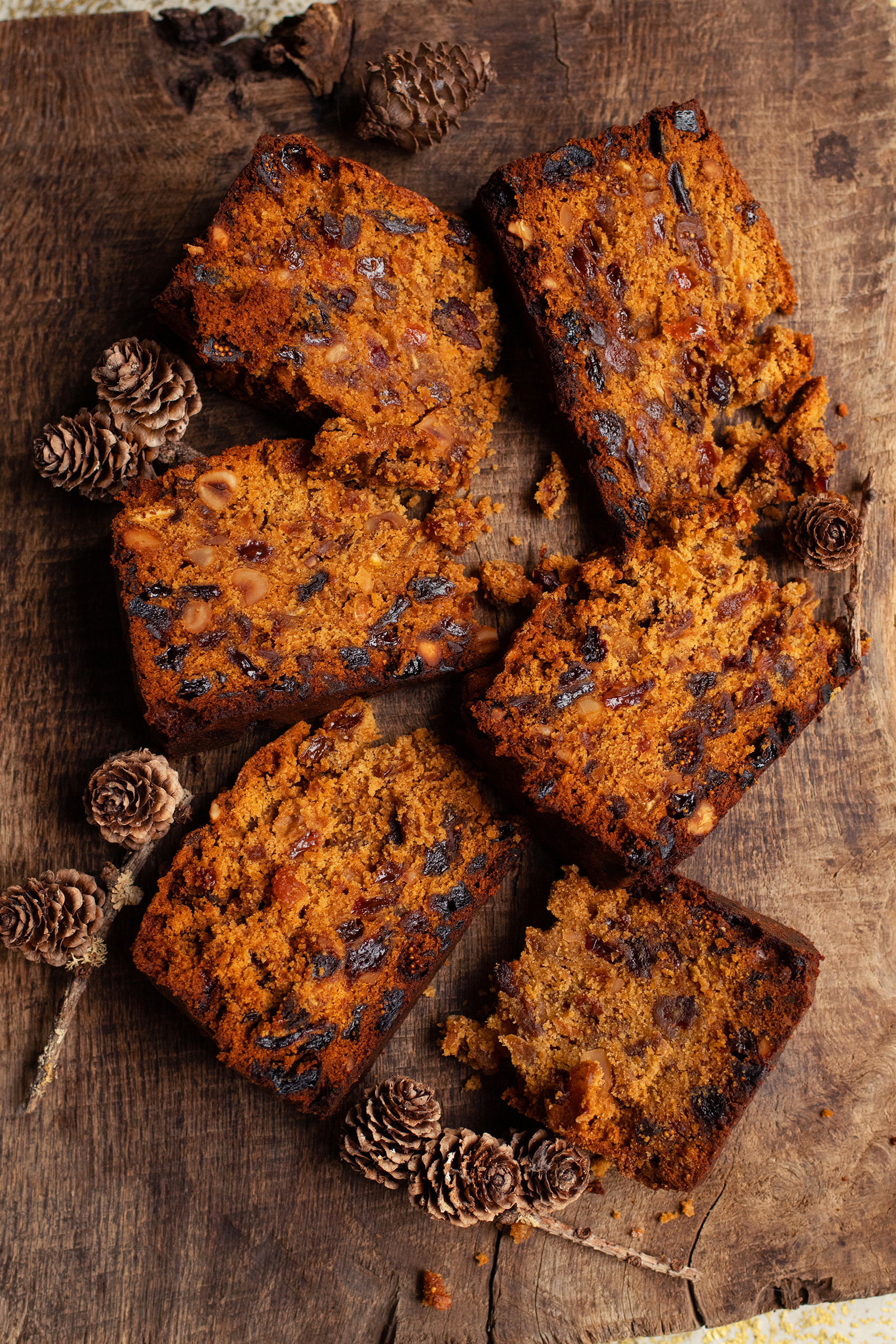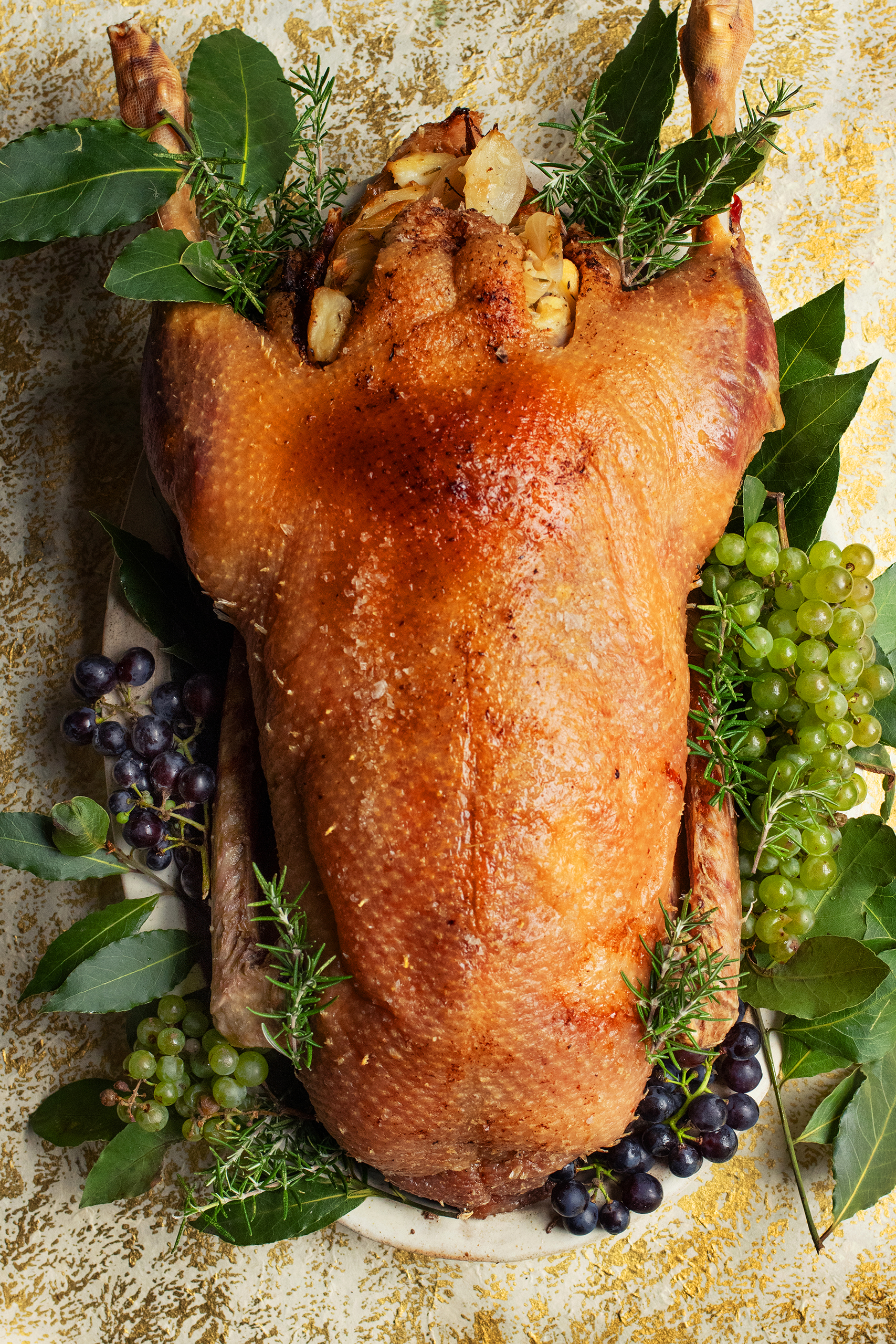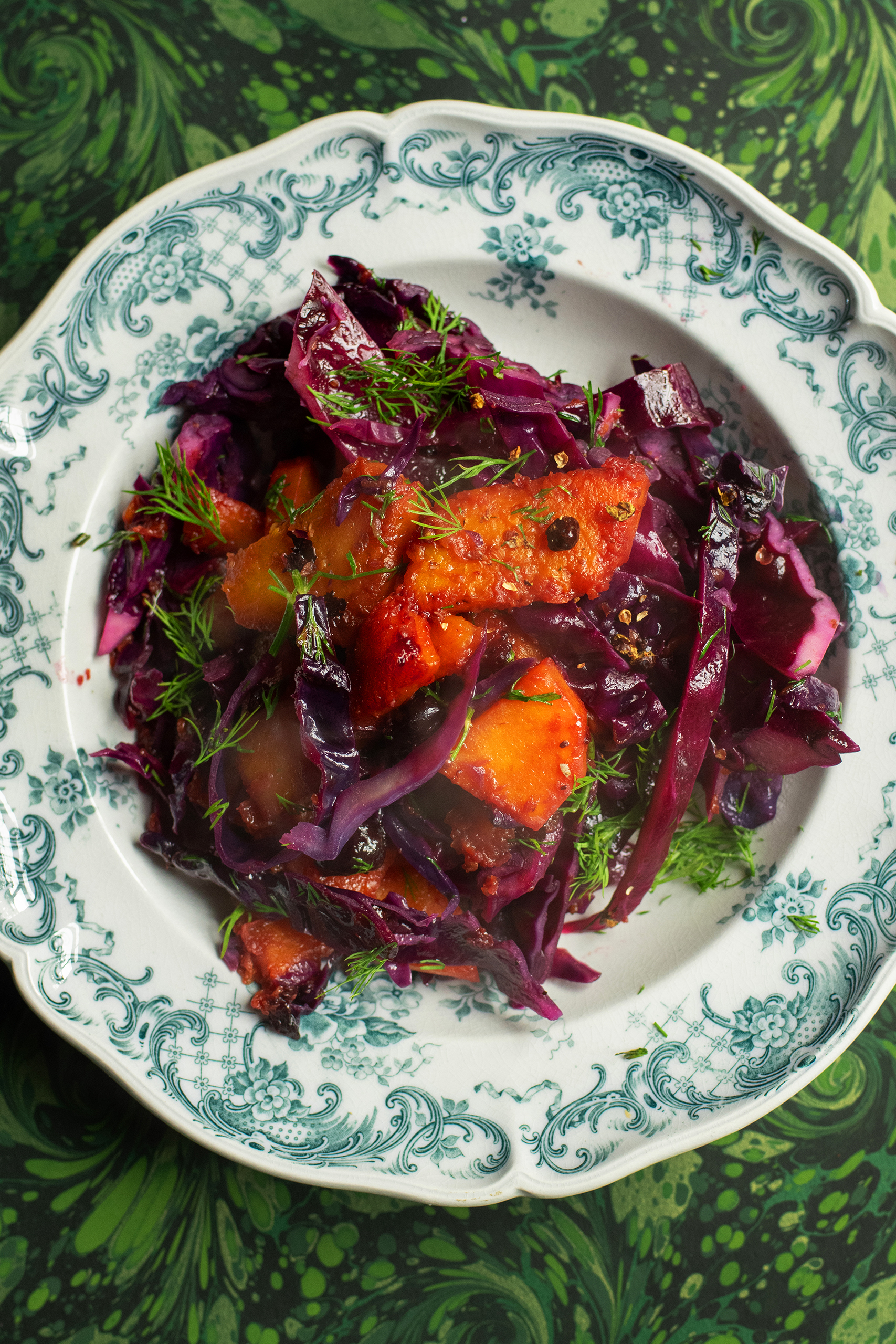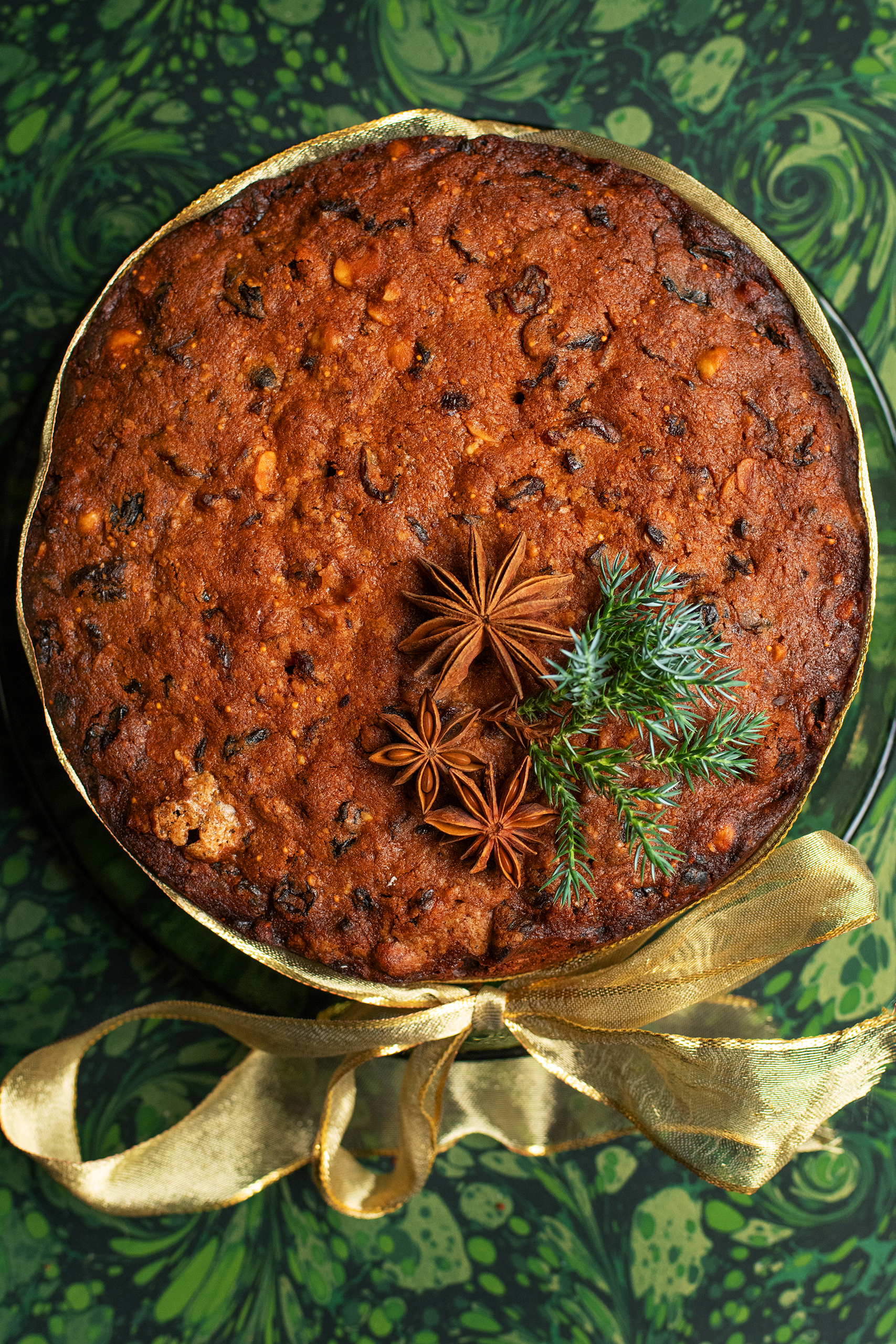There are certain Christmas recipes I cherish. Like the decorations on the tree, they rarely change. Roast goose is a regular visitor to this table, a stuffing of potatoes, thyme and lemon which soaks up some of the bird’s delicious fat. There is apple sauce, too. An unshakable accompaniment to the rich, sweet flesh of the goose.
It is essential to order your bird from the butcher, as they sell out quickly. You will be expected to part with a king’s ransom for a beautiful bird, but it is a gift that keeps on giving. First with the glistening skin and sweet breast and leg meat. Once the tender bits have been eaten, then it’s time to boil the bones for a good rich stock. The final gift is the fat that flows from the goose as it roasts. Fat so copious you may have to resort to a turkey baster to suck it all up. Once set, the snowy fat will keep for weeks in the fridge. After the meat has been carved from the bones, then it’s time for soup, with miso paste and butter beans.
To go with the goose, a pan of deep purple cabbage. It wouldn’t feel (or smell, or taste) like Christmas dinner without bringing a big dish of sweet-sour cabbage to eat with the goose. It is also a very fine side dish for a nut roast, and this year I will embellish the classic cabbage, juniper and fruit jelly recipe with slices of soft, fudgy pumpkin.
Once the dinner is over, the cabbage can be served cold aside a pork pie or cold nut roast, or stuffed into a goose or turkey sandwich with a slather of chilled apple sauce.

There just has to be cake. Perhaps not the full bells and whistles of the iced and marzipanned Christmas cake, but something nevertheless full of the essence of the feast. I bring out a rich fruit cake, stuffed with golden raisins, dried figs and dried apricots to eat with a cup of verbena or mint tea. I find such cakes very useful at this time of year – they can be brought out at any time during the season and their presence in the house is both homely and strangely decadent.
Lastly, the mince pie. The place for this diminutive stuffed sweetmeat is not after the main Christmas meal to cries of “no, I couldn’t eat another thing”, but at a time when their rich sweetness will be relished. Perhaps at midnight on Christmas Eve or about mid-morning on Boxing Day. Something worth serving warm, I think, when the pastry becomes even more fragile, and the filling softens to a brandy-scented, fruit-studded jam.
Roast goose with potatoes and lemon

I have stuffed the goose with potatoes and lemon this year. The potatoes soak up much of the goose’s glorious fat while the sourness of the lemon balances it.
A goose is a little more difficult to carve than a turkey, being a particularly awkward shape. The method below, where the breasts are carefully removed with a sharp knife and sliced on a board, makes the task easier and your goose will go further, too.
It goes without saying to take care when cooking a goose, but I really must mention the amount of scorching fat there is to deal with. Your roasting tray needs to be large and deep, so you can lift the goose without spilling the fat. I remove it from the roasting tin with a turkey baster rather than pouring it out. It is a gift, something to save and keep in the fridge for roasting potatoes for weeks to come.
Serves 6-8
goose 1 x 4.5-5kg, oven ready
floury white potatoes 1.3kg
banana shallots 400g, or medium onions
olive oil 3 tbsp
lemon 1
rosemary 3 large sprigs
thyme 10 sprigs
For the apple sauce
cooking apples 3 large, such as bramleys
lemons 2
cinnamon 1 stick
cloves 4
Remove the goose from its wrapping and place in a large, deep roasting tin. Peel the potatoes and quarter them, then cook them in boiling, lightly salted water for about 10 minutes, until they have just started to soften.
Peel and halve the shallots lengthways, remove the roots, then unfurl the layers. Warm the olive oil in a shallow pan over a moderate heat, add the shallots and cook until soft and golden.
Set the oven at 200C fan/gas mark 7. Drain the potatoes and return them to the dry saucepan, pressing down on them lightly with a potato masher or fork to slightly crush them. Squeeze in the juice of the lemon, then cover with a lid and let the potatoes infuse the juice. Reserve the squeezed lemon skin.
Pull the needles from the rosemary and roughly chop them, then chop the thyme leaves. Add the herbs to the potatoes, fold in the cooked shallots, then season with salt and black pepper. Stuff the mixture into the goose. A little may fall into the tin – no matter.
Season the skin of the goose with salt, add the lemon skins to the tin and place in the oven for 20 minutes, then lower the temperature to 160C fan/gas mark 4 and leave to roast for 90 minutes to 2 hours. Watch the progress carefully, covering the skin with foil if it appears to be browning too quickly. When it is ready, the skin should be walnut brown. (If the goose produces vast amounts of fat, and well it might, remove some carefully with a turkey baster or small ladle.)
While the goose roasts, make the apple sauce. Peel, core and roughly chop the apples. Put them in a heavy-based saucepan. Squeeze the lemons and add the juice to the pan with the cinnamon stick and cloves. Bring to the boil, then lower the heat and leave to simmer until the apples are soft. Remove and discard the cinnamon and cloves, then crush the apple sauce finely with a fork or a potato masher.
Lift the goose from the tin, place it on a warm serving platter and cover with tin foil. Rest for 15-20 minutes – this is important. Carefully ladle out most of the fat from the tin into a bowl or jar, let it cool, then store in the fridge.
When you’re ready to carve, place the goose on a chopping or carving board with a sheet of foil underneath to catch any juices. Using a long, sharp carving knife, make an incision as close as possible to the breastbone, at the open end of the goose. Slide the knife along the length of the bird, keeping as close to the breastbone as you can. Prise the meat away from the bone and slice downwards, the blade of your knife tight to the ribcage, removing the breast in one large, long piece. Now repeat with the other breast.
Move the carcass on to a warm serving dish, then cut the breast into short, thick slices, laying them next to the carcass. Cut slices from the legs, removing as much meat as you can and lay on the serving dish. Serve with the apple sauce and the potato stuffing.
Red cabbage with juniper and pumpkin

A fine dish to serve alongside the goose, the sweetness of the pumpkin tempered by the bitter notes of juniper. This is a good-natured dish, that will keep warm while you fiddle around with the roast. It also reheats well enough, should you need to bring out a side dish to cold meat, nut roast or a slice of pork pie the following day.
Serves 4
pumpkin or butternut squash 600g
groundnut oil 2 tbsp
red cabbage 500g
coriander seeds 10
juniper berries 8
star anise 2
cider vinegar 3 tbsp
fruit jelly 3 tbsp, redcurrant or apple
Peel the pumpkin or squash, remove any seeds and fibre, and cut the flesh into slices about ½cm thick. Warm the oil in a deep saucepan over a moderate heat and add the pumpkin or squash. Cook, turning once, until tender, about 15 minutes.
Finely shred the cabbage. Using a pestle and mortar, lightly crush the coriander seeds and juniper berries. Add the shredded cabbage to the pumpkin with the crushed coriander and juniper and the whole star anise, and cook, stirring regularly, till the cabbage starts to soften and is bright in colour, about 10-15 minutes.
Pour in the cider vinegar, let it sizzle, then cover with a lid so the cabbage continues cooking in its own steam for a few more minutes till soft. Add the fruit jelly and leave until it has melted and coated the cabbage and pumpkin.
Classic mince pies

A plump, sugar-crusted welcome. A sweet treat to offer to all-comers – preferably ever so slightly too hot – that can also be something with which to end a meal, with custard or a jug of cream. The tiny tarts filled with sweet mincemeat are one of the rituals of Christmas that everyone seems to have an opinion about. Puff pastry or shortcrust, icing sugar or caster, eaten hot or cold. Whatever your take, it simply wouldn’t be Christmas without them.
I like to make the pastry without sugar – the filling is sweet enough – and using half lard and half butter. Lard is increasingly difficult to find, so I often use all butter instead. The recipe here uses a tray of 12 x 3cm-deep tart tins, each hollow measuring about 6-7 cm in diameter. If your tins are shallower, and many are, then you can get as many as 18 small pies. Make sure to use a non-stick baking oil or spray (available from cookware shops and major supermarkets) on the tart tins to prevent the pastry from sticking.
Makes 12 deep mince pies
For the pastry
cold butter 75g
lard 75g
plain flour 300g
egg yolk 1
cold water a little
For the filling
good quality mincemeat 375g
To finish
egg 1
caster or icing sugar a little
You will need a 12-hole tart tin. Each hole should measure 6-7cm wide x 3cm deep.
Cut the butter and lard into small pieces and rub it into the flour with your fingertips. It should resemble coarse, fresh breadcrumbs. Use a food processor if you prefer. Add the egg yolk, then mix in enough water to bring it to a firm but rollable dough (a couple of tablespoons is usually enough).
On a lightly floured board, bring the dough to a ball, slice in half and chill one piece in the fridge. Roll the other out thinly using a floured rolling pin, then cut out 12 discs using an 8cm round cutter. Line the tart tins with the discs of pastry, pushing them well into the sides without stretching the pastry.
Fill the tarts with the mincemeat, each one should take about a level tablespoon. Set aside. Heat the oven to 180C fan/gas mark 6.
Roll the second ball of pastry out and cut lids to fit the tarts using a 6cm cutter. Using a brush or your finger, dampen the edges of the tarts with a little water, then place the second disc of pastry on top of each tart and press lightly to seal the edges.
Break the remaining egg into a small bowl, beat with a fork, then brush a little on the top of each tart. Sprinkle with a little sugar and bake for 20-25 minutes until golden. Should you wish, sprinkle with a little more caster or icing sugar as the tarts come from the oven.
TIPS I make a couple of batches of these tarts and store them an airtight container. They can be brought out and warmed in the oven at any point during the feasting.
Don’t be tempted to overfill the tarts, as they will bubble over and burn during baking.
Fruit cake for Christmas

I still delight at the sight of a Christmas cake with its waves of white icing and bottle-brush trees. Increasingly, I find a rich fruit cake sans icing or marzipan gets more takers. This is a generously fruited cake, less dense than the classic Christmas cake, but you could marzipan and ice it if you wish.
There is much debate about the merits of “feeding” a fruit cake. I do make mine a couple of weeks in advance and regularly pierce it with a skewer before dribbling brandy through the holes, but this one is ready to eat straight away.
The recipe makes a 20cm cake, which is more than enough for most households. (Larger cakes are also more prone to sinking in the middle.) It will keep well in a cake tin for a couple of weeks.
Makes 1 x 20cm cake. Serves at least 12
dried figs 200g
dried apricots 200g
prunes 100g
brandy or marsala 5 tbsp, plus extra for feeding
sultanas, raisins and cranberries 350g in total
orange finely grated zest and juice of 1
lemon finely grated zest and juice of 1 small
hazelnuts 100g, skinned
butter 250g
light muscovado sugar 125g
dark muscovado sugar 125g
free-range eggs 3 large
baking powder ½ tsp
plain flour 250g
ground almonds 65g
You will need a deep 20cm cake tin with a removable base. Line the base and sides with a double layer of lightly buttered greaseproof paper. It should come at least 5cm above the top of the tin. Set the oven to 140C fan/gas mark 3.
Snip the tough stalks from the figs, then chop them, the apricots and the prunes into small pieces, each about the size of a raisin, and put them in a mixing bowl. Pour in 4 tablespoons of the brandy or marsala, reserving the other for later, stir well so the fruits are moist and glossy, then set aside for about 30 minutes.
Put the sultanas, raisins and cranberries in a small bowl, stir in the remaining tablespoon of brandy or marsala, the orange and lemon zests and juices, and set aside.
In a dry, shallow pan over a moderate heat, toast the hazelnuts until golden, shaking the pan occasionally so they colour as evenly as possible, then tip on to a board and roughly chop.
Using a food mixer with a flat paddle beater, cream the butter and sugars till fluffy – the colour will get lighter the more you beat – pushing the mixture down the sides of the bowl from time to time with a rubber spatula. Break the eggs into a small bowl and beat them lightly with a fork, just enough to mix whites and yolks. Add the eggs to the mixture in four parts, mixing thoroughly between each one – it will curdle a little, but don’t worry. If it alarms you, then introduce a little of the flour.
Combine the baking powder, flour and ground almonds and add them, a few spoonfuls at a time, to the mix. Scoop the batter into the prepared tin with a rubber spatula, smoothing the top gently, then bake for an hour, then, without opening the oven door, turn the heat down to 130C/gas mark 2 and continue cooking for 1½ hours. If the cake is browning too quickly, place a piece of tin foil on top.
Check if the cake is done by inserting a skewer into the centre. It should come out with just a few crumbs attached, but no trace of raw mixture. If there is, continue baking for a further 15 minutes or so. Switch off the oven but leave the cake in place for 20 minutes, then take it out of the oven and leave to cool before removing it from the tin.
Feed the cake by pouring brandy into it every few days until Christmas. I do it at least once a week. Spike the cake all over with a skewer and trickle in a little brandy. Cover tightly with paper or foil and leave in a cake tin till needed. It will keep for several weeks.

